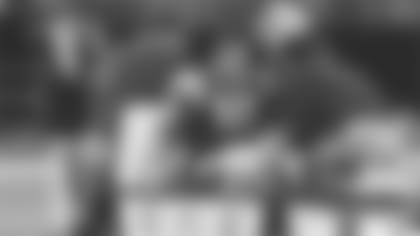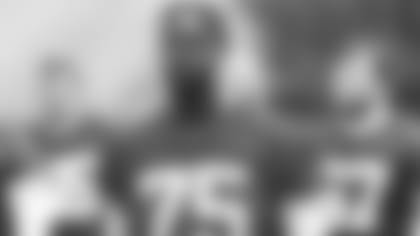*This is another in a season-long series on the Kansas City Chiefs search for a franchise quarterback. It appears weekly on Thursdays throughout the 2015 season.
*
Dick Vermeil and Trent Green were made for one another. No quarterback for the Chiefs ever had a more supportive head coach than Vermeil, or needed one at least at first in Kansas City. No coach ever had a more perfect quarterback to run his offense than Green, and run it he did with such precision that it became one of the most proficient scoring machines in NFL history for a time.
Vermeil had returned to head coaching, not to rebuild a team, but to make one more run at a championship with a team that he was led to believe still had a chance.
It was another new offensive system, and one in need of a quarterback who could run it. There was no time to lose, Vermeil believed, and Green would be the best person to run it.
First thing you noticed about Green was his disposition. He was happy, not Steve DeBerg jokester happy, just a pleasant guy who was happy to be playing after what had happened to him in St.Louis. What not to like, folks would say who met him, whether in press gatherings, on the street, or most important in the huddle. No snark, no thin-skinned insecurity or mean-spiritedness here.
He had been around, been a starter and not been, sort of like Rich Gannon although with a much shorter resume, and he had been all set to start for the soon-to-be champion St. Louis Rams and then he had a season-ending injury in the preseason and a guy named Kurt Warner took over. The rest, as they say, is history, Warner's history, not Green's.

An injury in the pre-season ended Green's Rams career
Whatever history he was to have would be made across state in Kansas City. Like Dawson had Stram, Green had Vermeil. It was the coach's nature to see one of his favorites succeed, so he pumped Carl Peterson to give up a number one pick to land Green and while it prompted outrage from some in the fan base, the trade in the end would turn out to be one of the best in Peterson's time in Kansas City. By the time he called it a career, Green would climb near the top of the list of greatest Chiefs quarterbacks.
But that wasn't known yet and in a fashion that had become all too fashionable, he struggled — better said, the team struggled — as it tried to put in place the high-scoring offense that had worked so well for Vermeil in St. Louis.
The proper disposition would mean a lot in withstanding the criticism that would come with being a Chiefs quarterback. Vermeil did much to silence it given his reputation as a Super Bowl winning coach and through the force of his own personality and media sensibilities.

Vermeil had Green's back from the day he brought him to KC
While Green had the offense down, his new team still had work to do, and in the first year there were many missing pieces and some debilitating losses for which Green took much of the blame. Playing quarterback had become a blood sport in Kansas City by now and whether he deserved it or not, all eyes were on the man playing the position.
Part of Green's struggle was due to four knee operations. The hit he had taken in St. Louis that had led to Warner's rise had ripped apart both his anterior cruciate and medial collateral ligaments as well as created other damage. "If Green fails to stay healthy, Peterson-Vermeil KC style will be a total bust," chirped one local columnist.
He was a journeyman, by most accounts, but then again, not really. He had been in the league since 1993 and while he could never be considered a Steve DeBerg in terms of experience, he had played pretty much just one full year where he attained a reputation of being a relatively accurate passer.
After being released by San Diego, where he had been its second-to-last pick, he sat out a year, went to Canada in 1994 to play for the BC Lions, but was released, landing in Washington as a third quarterback, beating out a host of others to keep the role. He threw one pass from 1995-1997.
But then he received his chance and for one season he played in 15 games, completing almost 55 percent of his passes for 3,441 yards and 23 touchdowns with only 11 interceptions. It was 1998 and the Redskins had lost their first seven games before winning six of their last nine. Then came a return to his home turf in St. Louis and finally to Kansas City in the trade.
"He was hired, fired, discarded, bombarded, benched, insulted, injured and now he's 30 years old, almost 31," was how one *Kansas City Star *columnist described the announcement that he had been traded here.
He was another older quarterback and it did not bring many rave reviews from a skeptical public. The team positioned the trade as a "package" with the signing of free agent running back Priest Holmes who had come over from Baltimore.
The 2001 season would be the first time he opened as the starting quarterback in his eight years in the NFL and he had his best game against his old team, the Redskins, completing 21 of 26 passes for 307 yards, including three TD's, to lead the Chiefs to their first victory, 45-13. Everything clicked as he led the offense to touchdowns on five consecutive possessions and threw a key block to spring a long run by Tony Richardson.
But that would be the highlight of his year. The team went into its fifth game of the season with Pittsburgh yet to win at home — the longest it had gone into a home schedule without a win since losing its first three games in 1980.
Green had come with a reputation for being a high percentage passer, but against Denver he was picked off four times, although his receivers had not helped much given the routes they ran. Derrick Alexander was injured much of the time and Green had to count on Snoop Minnis and Chris Thomas to catch passes. Sylvester Morris had been lost for the season. Tony Gonzalez was the only sure player Green could go to at times.
"We're not surrounding Trent with the kind of people he was surrounded with in the past," Vermeil explained. These were not St. Louis level receivers; this was not the Greatest Show on Turf, far from it.
"Green isn't winning and evidently isn't the same player," wrote a local reporter. "We've been through all that already here in Kansas City, Trent," scolded another. "It turns out Green is none of the things Vermeil promised," another complained, "nothing is more discouraging than the play of their quarterback." Talk radio was alive tearing into Green, one caller suggesting that the team should have taken another "Trent," Trent Dilfer.
At the end of his first year the Chiefs had a damaged player who had thrown 24 interceptions, most in the league and had finished with a dismal 71.1 passer rating. The team finished 6-10, although winning three of its last four games.
Next time: The essence of leadership













